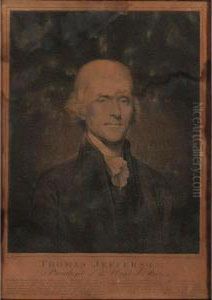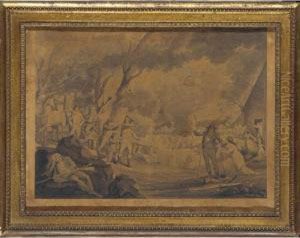Cornelius Tiebout Paintings
Cornelius Tiebout was an American engraver, recognized as one of the earliest and most distinguished in the United States during the late 18th and early 19th centuries. Born in 1777, in the burgeoning city of New York, Tiebout emerged in a period rich with political transformation and cultural development. His career spanned a significant era in American history, encapsulating the years following the Revolutionary War, a time when the newly independent nation was forging its identity, and art played a pivotal role in shaping and reflecting the country's ethos.
Tiebout's mastery in engraving, a technique involving etching designs onto metal plates, usually copper, set him apart in the early American art scene. He was adept in both line engraving and aquatint, a method that allowed for the creation of more tonal images, resembling watercolor paintings. This skill made his works highly sought after for book illustrations, portraits, and landscapes. Importantly, Tiebout's ability to capture the likeness and spirit of his subjects contributed significantly to the documentation and dissemination of American cultural and historical figures, thereby cementing his legacy in the art historical canon.
In the late 18th century, Tiebout traveled to London, a journey that was considered essential for any aspiring artist of the time. There, he honed his craft under the tutelage of renowned artists and engravers, including John Raphael Smith. This experience enriched his technique and exposed him to a broader artistic community. Upon returning to the United States, Tiebout settled in Philadelphia, which was then the nation's capital and a vibrant center for the arts. It was here that he produced some of his most memorable works, including engravings of George Washington, which are among the most iconic images of the first president.
Throughout his career, Cornelius Tiebout was instrumental in elevating the status of engraving as a fine art in America. His works were not only significant for their artistic merit but also for their role in the emerging print culture of the United States, helping to democratize art by making it more accessible to the public. Tiebout's engravings were widely distributed, appearing in books, periodicals, and as standalone pieces, thus contributing to the spread of both art and information across the young nation.
Cornelius Tiebout's death in 1832 marked the end of a prolific career, but his legacy endured. His contributions to American art were profound, laying the groundwork for future generations of artists and engravers. His body of work remains a vital record of the nation's early years, offering insight into the people, landscapes, and ethos of post-revolutionary America. Through his engravings, Cornelius Tiebout captured the essence of an era and helped to shape the visual narrative of American history.

